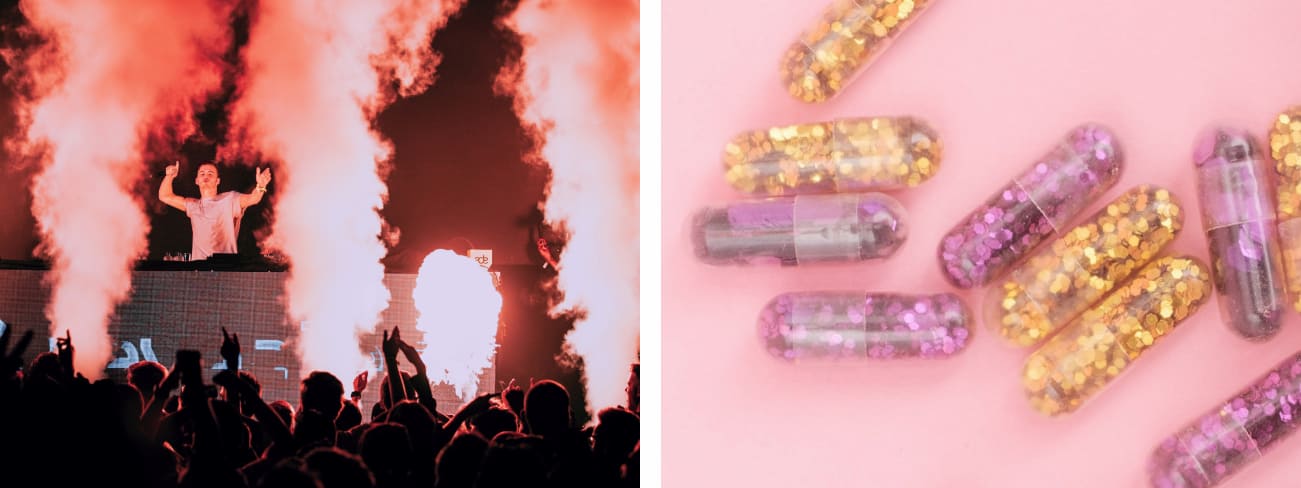Common Types of Party Drugs Young Adults Abuse During Spring Break
Reading Time: 6 minutesUse of a variety of common types of party drugs has reached record levels among young adults. In particular, use of the party drugs marijuana and hallucinogens is at historically high levels, according to a recent Monitoring the Future (MTF) study.
Young adults use party drugs to enhance social experiences and feel more intense emotions and sensations. These effects are created by changes in the brain and body—and those changes are dangerous and sometimes deadly. Many party drugs are also highly addictive. One of the biggest dangers of spring break is the potentially life-threatening abuse of these substances.
What Are Party Drugs and Why Do Young Adults Use Them?
Also known as club drugs, party drugs are substances that are commonly used at house parties, college parties, bars, nightclubs, and concerts. Many party drugs are psychoactive substances, meaning they directly affect the nervous system, creating changes in the users’ perception of reality. Most party drugs are illegal, but young adults also abuse prescription medications by using them recreationally.
In general, young adults use party drugs for one or more of the following reasons:
- To experience an altered reality
- They want to stop worrying and “get out of their own heads”
- In order to feel less inhibited and anxious in social situations
- Because friends are using them, and they don’t want to be left out of the experience
- As a way to self-medicate chronic or acute stress, trauma, depression, anxiety, or another mental health disorder
Questions?
All calls are always confidential.
Drug-Related Dangers of Spring Break
Spring break can be a risky time for young adults in terms of drug abuse. College students often use spring break as a time to release the stress of college and the academic pressure of the past few months. They may also be self-medicating college depression.
As a result, spring break drug use may contribute to the rising rates of overdose deaths among young people. In one recent case, six young men, including five West Point cadets on spring break in Florida, overdosed on cocaine that was laced with fentanyl.
“Since the beginning of the pandemic we’ve seen a tremendous increase in overdoses similar to this one. And those are the individuals who someone is there to call 911 to get them help. How many deaths are there where they do it by themselves, and there’s nobody around to call, and they’re just found deceased?”
Battalion Chief Stephen Gollan, Fort Lauderdale (Florida) Fire Rescue
New Research on Young Adult Substance Abuse
Research shows that substance use has increased overall due to the stress and collective trauma that this generation is experiencing. In a survey of 1,000 US young adults, feelings of loneliness directly predicted an increase in drinking and higher severity of drug use.
The MTF study found that nearly half of young adults, including both college students and those not enrolled in college, reported using marijuana. This represents a notable increase from MTF’s 2015 survey, when 38 percent reported marijuana use. Furthermore, daily or near-daily use of marijuana increased significantly among young adults. The study found that 8 percent of college students and 13 percent of young adults not attending college used marijuana on a daily or near-daily basis.
Moreover, use of hallucinogens reached its highest level since 1982. Nearly 9 percent of college students used hallucinogens in 2020. And 1 in 10 young adults not attending college reported hallucinogen use—the highest level in two decades.
According to a Global Drug Survey of 40,000 people around the world, global use of alcohol and benzodiazepines, such as Xanax and Valium, has also increased. The general anxiety and social anxiety created by the pandemic may be inducing more young people to turn to substances as a way to feel less worried and inhibited.
Know the Facts
44% of college students use marijuana, and 1 in 12 use it on a daily basis, according to a Monitoring the Future study.
5 Common Types of Party Drugs and Party Drug Effects
There are various types of party drugs, with a wide range of psychological and physiological effects. Almost all of these drugs carry the risk of death, particularly when combined with alcohol or other substances.
The most common types of party drugs fall into the following five categories.
Hallucinogens
This category of substances is generally divided into two types: classic hallucinogens, including LSD (known as acid), psilocybin (“magic mushrooms”), and peyote (mescaline); and dissociative drugs, such as PCP (“angel dust”), ketamine (“vitamin K”), dextromethorphan, and salvia. This type of party drugs affects the brain’s prefrontal cortex, distorting young adults’ perception of reality and catalyzing hallucinations that can be visual, auditory, or sensory. Hallucinogens can also create extreme mood changes, irrational thinking and behavior, feelings of disconnection from one’s body, anxiety, disorientation, and impaired motor function. The physical party drug effects of hallucinogens include trouble breathing, abnormal heart rate, increased body temperature, tremors, and numbness. Long-term effects can include psychotic episodes, visual and mood disturbances, suicidal thoughts, and memory loss.
MDMA, or Ecstasy
Also known as Molly or X, MDMA is a synthetic drug that acts as both a stimulant and a hallucinogen. One of the most common party drugs, MDMA creates feelings of euphoria and distorts the user’s sense of time and sensory perception, sometimes causing hallucinations and/or paranoia. This party drug’s effects include dehydration, nausea, faintness, chills, sweating, blurred vision, and a potentially fatal increase in body temperature. MDMA also affects heart rate and blood pressure and can create kidney damage as well as damage to brain cells. Hence, long-term use is linked with cognitive issues such as memory and learning deficits.
Inhalants
Inhalants are household, industrial, or medical products containing chemical vapors that produce a short-term high when inhaled, or “huffed.” Sometimes called “whippets,” “rush drugs,” or “nitrous,” (for nitrous oxide), they include solvents, aerosols, gases, and nitrites, found in products such as whipped cream containers, paint thinner, permanent markers, cleaning products, and amyl nitrate. Inhalant side effects include nausea, vomiting, delirium, muscle weakness, blackouts, and tremors.
Central Nervous System Depressants
In this category, the most commonly used party drugs areGHB (Gamma-hydroxybutyrate) and Rohypnol. Similar to prescription sedatives, these substances affect the central nervous system, resulting in muscle relaxation, drowsiness, and feelings of euphoria. The effects of repeated use include nausea, vomiting, confusion, memory loss, unconsciousness, lowered heart and respiratory rate, a decrease in body temperature, seizures, coma, and death. These substances are also known as date rape drugs, because assailants use them to sedate victims.
Stimulants
This category includes both illegal stimulants, including cocaine and methamphetamine (called meth or “crystal”), and prescription stimulants, like the ADHD drugs Aderall and Ritalin, which are often abused as party drugs. Stimulants are a popular party drug because they increase users’ focus and energy, producing bursts of activity and talkativeness. These drugs work by impacting certain parts of the brain that are involved with alertness. Stimulant party drug effects, particularly with meth and cocaine, include increased respiratory rate, heart rate, and blood pressure. Even so-called “casual” cocaine use can cause panic attacks, paranoia, and psychosis, as well as stroke, seizures, and coma. Long-term meth use leads to memory loss, psychosis, heart damage, malnutrition, severe dental problems, and an increased risk of infectious diseases, such as hepatitis and HIV/AIDS.


Signs of Drug Use in Young Adults
When the use of party drugs or other substances affects mood, physical health, relationships, and daily functioning at work or in school, this is a clear sign that a young adult is likely suffering from substance use disorder. Consequently, important warning flags include the following:
- Academic problems such as failing exams or skipping classes
- Extreme mood swings and emotional ups and downs
- Increased depression, anxiety, suicidal thoughts, and feelings of hopelessness and worthlessness
- Difficulty concentrating and finding the motivation to pursue life goals
- Asking parents or friends for money without explanation
- Problems with sleeping, including insomnia at night and sleeping during the day
- Pulling away from friends and family, and/or developing a new friend group of peers who are also abusing drugs
- Unhealthy physical appearance, including skin problems, weight loss or gain, and poor grooming
- Increased tolerance for a drug and withdrawal symptoms when not using
- Reckless behavior, such as unprotected sex, abusive behavior, vandalism, and unsafe driving.
Any of these behaviors over time is a possible indicator that a young adult is struggling with a substance abuse disorder, which may involve party drugs, alcohol, or other substances. Hence, they should have an assessment and be provided access to appropriate young adult drug treatment immediately.
Young Adult Drug Treatment at Newport Institute
At Newport Institute, we treat maladaptive behaviors, such as substance abuse, as symptoms of underlying mental health conditions, including trauma, depression, and anxiety. Therefore, our approach to treating these co-occurring disorders involves healing the root causes of the problem, not just the outward manifestations.
Through Newport’s integrated approach, young adults heal on multiple levels—mentally, emotionally, spiritually, and physically—with the support of medical and behavioral healthcare experts. Each client’s tailored treatment plan includes a wide range of clinical, experiential, and life skills/academic modalities, to support enhanced executive functioning, the development of healthy coping skills, and positive, nurturing relationships. Contact us today to learn more about our clinical model for young adult drug treatment.

